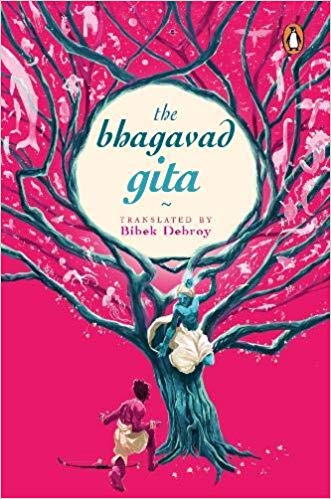So much has been written about the Bhagavad Gita and so much still remains. There is always a new voice, a new thought and a new lens to look at this beautiful and majestic ancient text. If you are a seeker in life, and if you find yourself pondering over questions about life and living, it is safe to say that the Bhagavad Gita has the answers. However, each person or each seeker will derive their own answer from it. Such is the beauty of the Gita.
The Bhagavad Gita translated by Bibek Debroy is a heartfelt attempt to bring the richness of this ancient text to modern readers. There are several translations of the Gita not only in English but other languages as well. Why do you need a new one? The answer, as per the author lies in the fact that each generation should have its own translation. Moreover, one may feel that sometimes the language used in the earlier translations is a bit outdated.


Right in the beginning, Debroy establishes the fact that his book is a pure translation and not an interpretation. I think this is very significant since it allows for the modern reader to derive his own meaning from the text. In the introduction Debroy has deliberated a lot on different aspects of translations and interpretations of the Gita by writers over time. Those interested in the nuances of translations will find this quite useful.
However, the biggest strength of this book lies in the main body of translation. The manner in which the translation is presented makes it very approachable for the reader. There is a brief introduction to each chapter. Then there is the original text on the left and an English translation at the right. I think the division of the text into the chapters and the presentation thereof makes it very accessible to the modern reader. It is not overwhelming and you feel brave enough to pick up the book and read it!
There is an extensive section of notes at the end of the book. This gives a lot of chapter wise background information, which is handy for those who give to have some extra background information on the intricacies of the translation or comments thereof.
A long time back an old and wise person gifted me with a copy of the Gita in Devanagari script. He advised me to seek meaning from it, and told me that the meaning I derive from the Gita would change as I grew in life. Today, as I read Debroys translation, these words ring true. This is a book to be savoured. Let it lead you to think, introspect and contemplate. Surprisingly, I find this a good book to keep on the bedside table and mull over few verses, reread some and leave some for another day, when their time comes! Whatever the case, I am sure of one thing, as Debroy also asserts in one of the chapters, “Happiness comes from the Gita,”!




